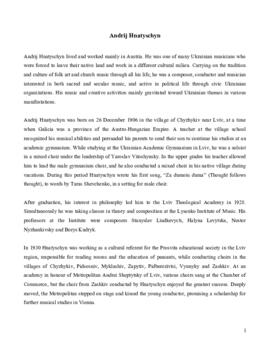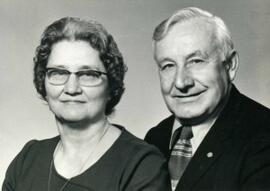Born August 20, 1926 in Kingston. His father came to Canada in 1912 from Kamianets-Podil’s’k, worked in tannery, went back to Ukraine in 1914, married his mother and left her there. She came only in 1925. His father never joined any organizations. The first group of Ukrainians in Kingston worked for the Tan Hightes Company (???). Learned English only when went to school. Small community of Ukrainians in Kingston when Andriesky was growing up but no basic organizations. Had yearly parties like Malanka. Still there was a Ukrainian school in a private house where children learned the language. No Ukrainian church back then, only Roman-Catholic cathedral (in the late 1930s there were 2 of them already). Priest Boreky (???) who later became a bishop. Felt foreigners because of the last name. Most of the Ukrainians were in the city. Had a Jason Farm next to them, there was Braznyky (???) family. Kotovych and Vudiks (???) came in the 1930s, but not much of an immigration to the Kingston area between the wars. Then Nyc Gulka came into town and split the community up, and they started to build a Hall (UNF). Fascists vs Commies camps. Andriesky’s father subscribed to a Ukrainian newspaper. During WWII Andriesky made corvettes. In about 1946-48 the community really polarized: either Fascists or Communists. DPs developed a new Hall. John Sapletynsky (???) was the last treasure of the original Hall (Labor Temple). Andriesky’s organization operated under a warrant of the Ontario Company’s Act. Fred Katovich (???)
Kingston had between 25000-30000 population between the wars, not it is a diverse community. Andriesky is an electronic technician repairing appliances now. Wife - Wilda Helen Andriesky (nee Harker), her mother was German and father was a methodist minister. have no children. Three dancing Ukrainian groups in the community: Maky, Sadochok, The Doors - all run by the Ukrainian-Canadian Club of Kingston that was formed 3 years ago. Andriesky helped to write its Constitution. Liubomyr Lutsiuk was the originator. Tarnowecky (???) married the John Wytyk’s daughter, and started a professional dance group, which now stations in Toronto.
File contains one biography on Andrij Hnatyschyn written by Taras Filenko and translated by Lada Hornjatkevyc.
Recorded in Ukraine
Kikot, AndrijThrough observation and interviews with participants and organizers of a specific festival, describes the cultural revival of St. Andrew's Day Festival at St. Andrew's Ukrainian Orthodox Parish of Edmonton
Hohol, KeenanAndriy Nahachewsky is talking to the Basilian brother inside the Sagrada familia Iracema Church, Santa Catarina. One can notice ritual gesture of Basilian brother, (fragment of church interior)
Andriy Nahachewsky is talking to the Basilian brother inside the Sagrada familia Iracema Church, Santa Catarina. (Fragment of church interior)
This collection contains the results of two ethnographic trips to the Ukrainian communities in Brazil by Andriy Nahachewsky. The first trip took place from 4 May to 26 May 2009, and included Andriy Nahachewsky, Serge Cipko, John C. Lehr, and Maryna Hrymych. This was the first trip to Brazil for each of the participants, though they each had strong credentials in their disciplines and in fieldwork more generally. Thus the project goal was to cast a wide net for general orientation into the historical and contemporary life of the Ukrainian communities there. Each researcher also had specific personal goals. The trip included visits to Curitiba, Prudentópolis and several rural communities nearby, Craveiro in Santa Catarina, São Paulo, Brasília, and Foz do Iguaçu. The agenda included visits to an agricultural cooperative, meetings with diplomats and organizational representatives, and diverse individuals who could speak about life in their communities. Photographs by Hrymych, Lehr, and Cipko are also accessioned into the BMUFA and located in their own respective collections.
The second trip was undertaken by Andriy Nahachewsky, for 6 months from 14 November 2009 to 13 May 2010. The goal of the project was to continue the first exploratory fieldtrip, intensifying and expanding it. The project had a strong diachronic focus, documenting change in cultural traditions, to understand better how Ukrainian cultural content, rooted in 19th century rural traditions in western Ukraine, became transplanted, disappeared, adapted, and sometimes newly created in its diaspora setting in the Brazilian context. The intent was to be able to compare these processes with similar ones known from the Ukrainian Canadian context, as well as culture in western Ukraine itself, which also changed significantly over the 20th century: One cultural root, and three branches evolving on three continents over 120 years.
Another aspect of the fieldtrip was connected with Nahachewsky’s earlier “Local Culture and Diversity on the Prairies” project, which strove to provide documentation about regional differences in traditional Ukrainian culture in the Canadian setting. This аspect of the project was to try trace local differences in Brazilian culture in a similar way. Some of these regional differences were probably most clear in past decades. A third aspect was more synchronic, aimed to document contemporary life. Connected with this, the Brazil trip involved travelling to some 65 communities in the states of Paraná, Santa Catarina, Rio de Janeiro, and São Paulo, the main Ukrainian settlement areas in Brazil. The project involved recording some 300 audio interviews, 53 hours of video recordings of contemporary events, 14,000 photographs, and gathering many publications and manuscripts (in hard copy and reproduced digitally), as well as diverse artifacts. The overall focus in subject matter was broad, including material culture (farming practices, folk arts), customs (calendar holidays, weddings, funerals, etc) and performing arts (music, dance). Special foci developed for dance materials, religious images, church architecture, cemeteries, music, and weddings, because of Nahachewsky’s research background, opportunities, and experiences as the fieldwork proceeded. The trips were both funded by the Huculak Chair and the Kule Folklore Centre (for the first trip: Nahachewsky, Hrymych, and various shared expenses). During both trips, the hosts in the home base in Prudentópolis, as well as other locations in Brazil, were very warm and hospitable, open, and generous. A copy of the digital photo, audio, and video fieldwork materials was deposited in the Museu do Milênio in Prudentópolis.
Nahachewsky, AndriyThe collection consists of various course assignments submitted by Andriy when he was a master and PhD student in the Ukrainian Folklore Program at the University of Alberta. The assignments cover different topics of Ukrainian and Ukrainian Canadian traditional culture and folklore, and include field recordings as well as final essays.
Nahachewsky, AndriyAndriy Nahachewsky is talking to Sister Servant during the festive lunch after F. Malinowsky ordination ceremony. (Sisters Servants clothing)
Andriy Nahachewsky is talking to Sister Servant during the festive lunch after F. Malinowsky ordination ceremony. (Sisters Servants clothing)
Part 1: Was born in Halychyna, Radykhiv povit, on April 14, 1907. He is Orthodox but initially his relatives were probably Catholics. They already had an uncle and grandfather in Canada. His father emigrated in about 1912-1913. His brother was at that time 4 y.o. and sister 2 y.o. Coming via Amsterdam to Halifax. Got some disease during the trip and was held in a quarantine upon arrival. His father died when he was 7. He was adopted by childless relatives, and stayed with them till the end of the school term. There was no Ukrainian schools back then. He became a teacher. Catholics and Orthodox relations. Ukrainian teachers and students. Stechyshyn (???) was a rector of the Orthodox Institute. Hnatyshyn, Matiuk, Dr. Savitsky (???) were his unofficial deputies. Sencus was one of the best friends of Andruschak. Teacher’s responsibilities and curriculum. Church choir.
Part 2: Soiuz ukrainskykh samostiinykiv. Father Pliak (??). Creation of the CUC. Congresses of the CUC. DPs and helping them, and relations with the newcomers.
Natalka Andrusyshyn (nee Ostashevs’ka) born on September 25, 1905 in Korcheva, Rava Rus’ka. Came to Canada in 1928. Her brother and husband organized a Chytal’nia in Canada. Her mother died in 1927. Her husband was 10 years older, born in Shchepiatyn. Her brother and husband went to Canada and settled in Montreal, and sent for her. She arrived to Halifax by the boat “Estonia”. On Sheptyts’koho the first pioneers were the Borshchevski. Father John started building a church in 1925-26. Neighbors were Slovaks and Hungarians. Father Lukashuk. Harsh winter life. Moved from Sheptyts’koho 17 years and moved to Vaz D’or in 1946. Sheptytskoho was renamed in 1936 into Castaneda (???) when Frenchmen arrived from Montreal over there and burnt the school and monastery.
IUrii Sup was born on May 6, 1926 100 miles from Montreal. His parents came to Canada in 1907. They had some business in the Old Country but lost it to a fire 3 times, after the 3rd time they left for Canada. They arrived to Sheptytskyi in 1929.
Ivan Smoly was born on 21 March 1908 in Sokal’, village of Hil’tsi (???). Came to Canada in 1927 to a farm in Crydor (???), Saskatchewan (arrived to Halifax by a boat).
Maria Sup-Smoly (sister of Ivan Smoly) born on March 23, 1921. Came to Sheptytskyi in 1929. There was UNO organization in Val D’or and people from Sheptytskyi would come to it (it was organized in about 1935-36). Mr. Mazuryk was its head. There was no Ukrainian church, so that when Father Horoshko would come he would run services in a Hall where an altar would be put (later on Horoshko left for the Orthodox church). Orthodox priest would come: Pareniuk, Skorbnyk, Shchavel’, Tsiupka, Lotytskyi, Zhykhuda(???), Chaika (the current priest). Ukrainian church in Val D’or was built in 1953 under Father Chaika.
This collection includes wedding songs, winter cycle songs, and various other songs sung by Maria Mazuryk.
Biscoe, Anna





